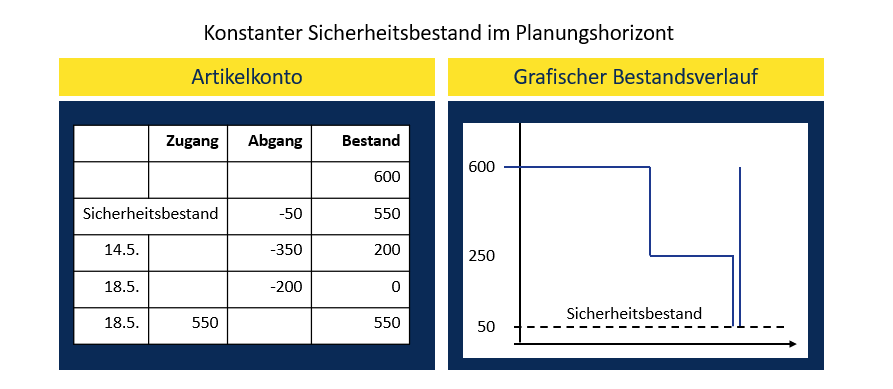Safety stocks are an important tool in materials management. They are used to avoid supply gaps and ensure the ability to deliver a material to the market or an internal consumer such as production. There is a statistical correlation between the uncertainty of demand, the desired delivery capability and the replenishment time of an item.
It has long been state of the art to regularly recalculate safety stocks, although many ERP or add-on systems only work with inadequate algorithms. However, such regularly recalculated safety stocks apply at a constant level over the entire observation horizon of the future (planning period).
In the tabular stock account of an item, such a constant safety stock is usually deducted directly from the available item stock. In a graphical representation of the stock flow, the safety stock can be recognized as a horizontal line.
For items with long replenishment times, this type of safety stock approach often falls short. For example, if you have to order items in October for the coming March, you must already take into account in October how much safety stock is likely to be required in March. Otherwise, there will either be no safety stock or there will be too much stock.
It is precisely this weakness of the normal safety stock calculation that the safety stock dynamics approach eliminates. The safety stock dynamic virtually forecasts the development of the future safety stock over the course of the planning horizon. In this way, even with long replenishment times, it is possible to anticipate which safety stock will be required at the time of a future goods delivery and can be taken into account when ordering materials.

Our tip:
If your ERP system, merchandise management system or inventory management system has a safety stock dynamic, you should at least activate it for items with replenishment times of more than 28 days.
If your system does not have safety stock dynamics, you should at least determine the safety stocks automatically using statistical methods.
If you are not satisfied with the quality of the statistically determined safety stocks, you should urgently introduce a qualified add-on system and carry out an automated calculation according to rules of thumb in the meantime. The alternative to properly calculated safety stock levels, setting safety stock levels manually, is grossly negligent and regularly leads to poor delivery capability and excessive stock levels.


